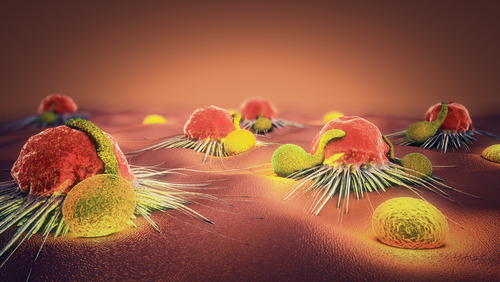An analysis of tumor samples collected during the IMvigor210 Phase 2 clinical trial has revealed a mechanism of cancer cell resistance to immune checkpoint inhibitors like Tecentriq (atezolizumab).
The findings will help predict which patients are likely to respond to checkpoint inhibitors and may pave the way for novel approaches that improve the effectiveness of these immunotherapies.
The study, “TGF-β signalling attenuates tumour response to PD-L1 checkpoint blockade by contributing to retention of T cells in the peritumoural stroma,” was presented during the ESMO Immuno Oncology Congress 2017, in Geneva, Switzerland.
Inhibition of the PD-L1/PD-1 signaling pathway with recombinant antibodies is a safe and effective approach to promote durable anti-cancer responses in several solid tumors. However, only a subset of patients seems to benefit from these therapies, suggesting that the remaining tumors have an inherent treatment-evasion mechanism.
“Understanding why the remaining 70-80% [of patients] are resistant [to checkpoint inhibitors] would enable us to target the mechanism with an additional drug and extend the benefits of checkpoint inhibitors to more patients,” Sanjeev Mariathasan, PhD, lead author of the study, said in a press release. Mariathasan is senior scientist in the Oncology Biomarker Department at Genentech, maker of Tecentriq.
In an attempt to identify potential biomarkers that predicted the resistance to immune checkpoint inhibitors, researchers examined cancer tissue samples from patients included in the IMvigor210 Phase 2 trial (NCT02108652).
The study enrolled 310 patients with locally advanced or metastatic urothelial carcinoma (mUC), who received 1,200 mg of Tecentriq every three weeks until they no longer benefited from the treatment. Efficacy data showed that only 22 percent of patients responded to the treatment.
Three independent biological features of cancer cells were found to be correlated with different responses to Tecentriq.
Tumors with more genetic mutations and those with increased amounts of infiltrating immune cells had the best responses to the treatment. In contrast, tumors with increased amounts of TGF-β responded poorly to Tecentriq.
Based on the immune content of each tumor, the team identified three types of tumor microenvironment: tumors with few anti-cancer T-cells (called “immune desert” tumors), tumors with T-cells only in their surroundings, but not inside (called “T-cell excluded tumors,”), and tumors with T-cell infiltration (called “T-cell inflamed tumors”).
T-cell excluded tumors were the most common, found in 50 percent of patients. The remaining two types were each observed in 25 percent of patients.
The findings suggested that TGF-β could be the factor produced by cancer cells to prevent T-cells from penetrating the tumor.
“This suggests that giving anti-TGF-β and anti-PD-L1 together can remodel the stromal microenvironment and allow T-cells into the tumor. The ‘T cell excluded’ phenotype is common in other cancers such as lung, pancreatic and colorectal, so this combination therapy could be tested in a wider group,” Mariathasan said.
Using a mouse model that simulated a T-cell excluded tumor microenvironment, the team tested if an anti-TGF-β drug could be used to enhance the effectiveness of anti-PD-L1 therapies. Indeed, the combination allowed the T-cells to penetrate the tumors, triggering tumor shrinkage.
“The ‘T-cell excluded tumors’ are the low hanging fruit in terms of clinical opportunity,” said George Coukos, congress co-chair, professor and director of the Department of Oncology at Centre Hospitalier Universitaire Vaudois (CHUV) and University of Lausanne (UNIL), in Switzerland. “[This discovery] opens the door for improving therapeutic responses to PD-1/PD-L1 blockade by simultaneously targeting the TGF-β pathway.”
Clinical trials now are necessary to evaluate the safety and effectiveness of anti-TGF-β and anti-PD-L1 combo therapies as treatment for advanced bladder cancer. Additional studies are warranted to assess if these features are shared by other cancer types, study authors said.


